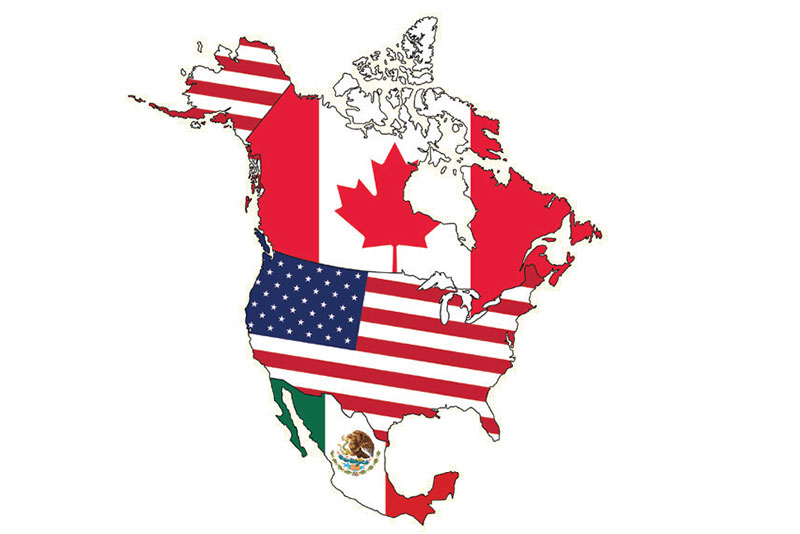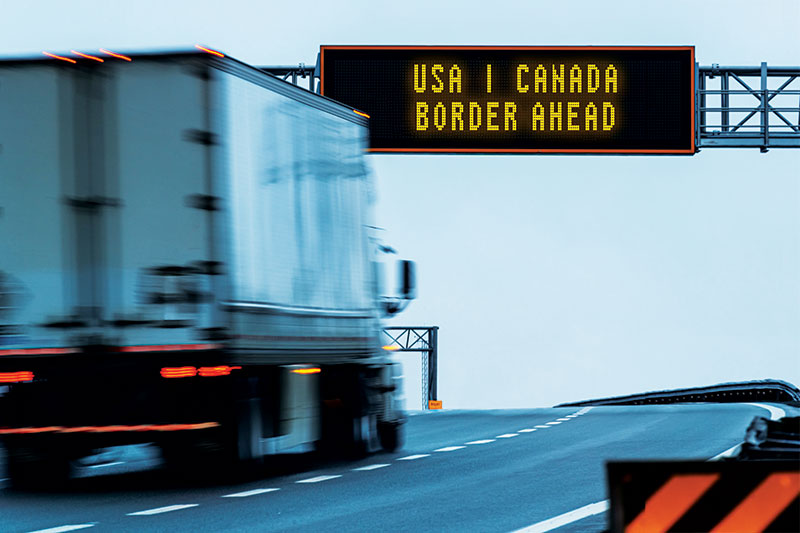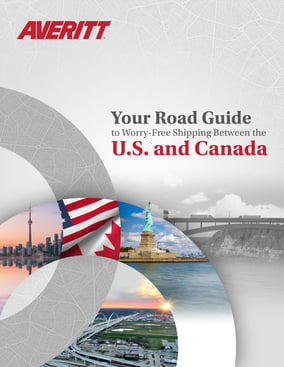2023 Cross-border Update: Business Booms
What has been called “phenomenal” growth in near-shoring will only increase cross-border trade as manufacturers seek sites closer to their markets. While freight transportation providers are streamlining cross-border moves with strong data, partnerships, and expertise, there’s still a lot shippers need to understand before setting up a long-term strategy.
What has been called “phenomenal” growth in near-shoring will only increase cross-border trade as manufacturers seek sites closer to their markets. While freight transportation providers are streamlining cross-border moves with strong data, partnerships, and expertise, there’s still a lot shippers
need to understand before setting up a long-term strategy.
Despite all of those shifts, the overwhelming bottom line is that there’s more freight than ever moving across the borders of the United States, Canada and Mexico. And because there’s so much more freight arriving inbound from Mexico than is heading south to the Rio Grande, that natural freight imbalance is causing some headaches for trucking executives specializing in those north-south lanes.
“The challenge is to get enough southbound freight to make it work profitably,” says Greg Orr, president of CFI, a major truckload carrier that has more than three decades experience in hauling north-south loads to the U.S.-Mexico border. “There’s not enough offset on rates to make it profitable, and we have to figure out how to export more.”
But for shippers in the north-south trade, the message from experts in the market is clear: Do your research, don’t cut corners when it comes to Customs and paperwork, and understand that operating in and out of Mexico or Canada is not always like shipping within the United States.
“The No. 1 key for us is to have a reputable carrier that knows what it’s doing,” says Rock Magnan, president of RK Logistics, a third-party logistics company based in Fremont, Calif. “We prefer U.S.-based carriers—someone like J.B. Hunt, Landstar, C.R. England, or CFI. They’ve all been around a long time with a lot of experience in that marketplace.”
With trade among the three North American countries booming, let’s take our annual look into why that’s happening; examine the latest on near-shoring; and then break down what’s driving the trends and challenges facing U.S. shippers moving across the borders to Canada and Mexico.
Size of the market
Cross-border freight traffic among the three North American trading partners is simply huge. Here are some facts: In 2022, according to the DOT Bureau of Transportation Statistics (BTS), Canada surpassed Mexico as the No. 1 trading partner in terms of trading value. China was third.
And it has continued to grow as we move through 2023. North American transborder truck freight in January, the latest month for which figures are available, jumped nearly 13% from the same month last year. In overall freight values, trucking continued to capture the largest share—some $77 billion. That represented the bulk of the total $125.8 billion of transborder freight moved by all modes of transportation. In January alone, truck trade across the U.S.-Mexico border accounted for $44.7 billion.
In 2022, transborder trade in and out of Mexico totaled $792.7 billion, according to the BTS. Last year, according to the Census Department, the U.S. exported $324 billion of goods to Mexico while imports from that country totaled $454 billion. That compared with $276 billion in exports and $384 billion in imports in 2021.
Canada isn’t too far behind. According to the U.S. Census Bureau, in 2022 the United States imported $437 billion of goods from Canada. The United States exported $356 billion of goods to Canada last year.
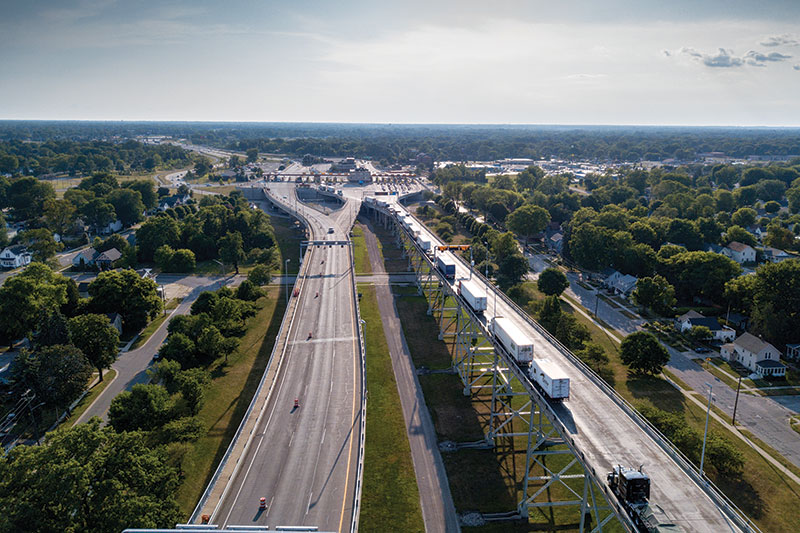
Nearshoring: Good for transport
By far, trucking gets the lion’s share of cross-border freight. Trucks transported more than 81.8% of the value of surface trade—$947.9 billion in transborder trade. Rail was next at $210 billion, according to the BTS.
However, that $210 billion in rail trade was large enough to be a major factor in Canadian Pacific Railway’s decision this year to buy Kansas City Southern for $31 billion. That paves the way for the first, single-line railroad linking the United States, Mexico, and Canada.
All of this is good news for north-south truckers who specialize in cross-border trade. It’s also good for Canadian Pacific Kansas City, the new name of the so-called “NAFTA railroad” that has carved out a lucrative niche in hauling heavy materials in and out of Mexico.
That’s because shippers are increasingly embracing nearshoring and reshoring of sourcing and manufacturing. It’s all part of an overall strategy to shorten supply chains, reduce risk of disruption and failure and respond faster to U.S. consumer demand.
Mexico is at the top of the list. Even Chinese firms are locating manufacturing plants along the U.S.-Mexico border. The latest of a string of Fortune 100 companies to announce a manufacturing outlet in Mexico near the U.S. border was Tesla. The electric-car marker said it would build a plant in the Mexican industrial hub of Monterrey.
That follows BMW’s announcement in February that it would invest about $850 million to produce electric cars in the Mexican state of San Luis Potosi. Experts and transport executives say rising costs to manufacture in China, disrupted supply chains causing shortages of all manner of goods, as well as congested transportation networks are all driving U.S. companies to more actively consider bringing manufacturing closer to the United States—and Mexico is becoming an increasingly popular choice.
Rosemary Coates, executive director of The Reshoring Institute, a research and consulting organization that helps provide companies research on site relocation, said she “lit up” when President Biden spoke of his “Buy American” initiative recently.
“I think it’s an enormous windfall,” says Coates. “I was at the Otay Mesa freight border crossing in California recently, and the amount of manufacturing growth there was jaw-dropping.”
The main reason for that growth is based on moves to avoid tariffs as high as 25% on incoming manufacturing from China and elsewhere. Provided these Mexico plants are producing Mexican-origin products by Mexican workers, those tariffs are waived. “This is a big deal,” says Coates. “It’s a 25% savings.”
When Coates studied global wage rates, she found China is no longer the lowest cost for wages. Mexico is a good choice—labor rates are low and near to U.S. markets is another positive (see Logistics Management, January 2023).
“All of these factors combined are making Mexico very attractive,” adds Coates. “It’s a phenomenal benefit at the border.”
Some pitfalls to avoid
Cross-border shipping experts say that the biggest challenge is the amount of paperwork required—not an easy thing to do alone. Experts say that it’s wise to rely on companies such as freight forwarders to complete export and import paperwork and seemingly simple tasks like finding a warehouse to drop a trailer at the border.
“It’s not impossible. It’s done thousands of times every day, but it requires some expertise,” says Coates. And since the pandemic struck three years ago, supply chains have gotten smarter. In fact, strategies are better, as is execution.
“We didn’t used to worry about strategy,” says Coates. “It was simply: make it in China and move it. Now, strategy is part of the execution as well.”
The result is mostly a well-oiled supply chain. “I haven’t heard many complaints from my customers who operate south of the border,” says Coates. “They use regular carriers and forwarders, an it’s a matter of learning the processes and getting used to it.”
Orr of CFI, which has an extensive Mexico presence after more than 30 years of experience in that market, says shippers should be aware of the chance they’re taking with a no-name carrier south of the border. “We have a secure base of carriers and many protocols in place,” he says. “We also have very specific, set measures to assure we don’t have drug trafficking coming across in our trucks. Shippers never want their names associated with that business.”
Additionally, shippers should consult with a forwarder to ensure that customs paperwork is filled properly ahead of the border. This eliminates delays at the border. Also, shippers are advised to use truckers who are part of the Free and Secure Trade (FAST) program. Recently, those truckers enjoyed access to a new, $10.3 million, four-lane expedited border crossing at Laredo, Texas, to avoid congestion at the World Trade Bridge there.
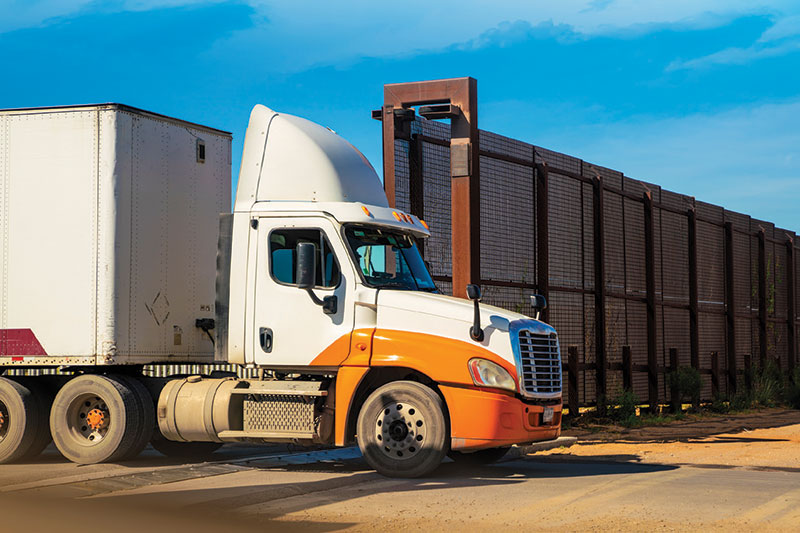
The FAST program began in the wake of 9/11 to provide faster clearance of freight by known shippers who are part of a larger “trusted shipper” program that allows for expedited freight clearance at the border. It’s all part of the decision-making process cross-border shippers should make about hot to identify their strategy, how to avoid or minimize risk, how to identify costs and understand tradeoffs.
“What countless Mexico shippers realized beginning in 2020 was the criticality of partnering with a diversified cross-border partner,” says Jason Dekker, CFI’s director of international business development. He adds that there was severe imbalance and virtually no additional outbound capacity in major manufacturing markets such as Puebla, Guadalajara and Monterrey.
“It doesn’t take much in these major Mexican markets to seize up capacity,” adds Dekker. “Having a diversified provider that’s hyper-focused on bringing a variety of trucking and distribution solutions to the table is the key to supply chain stability in a growing freight market.”

